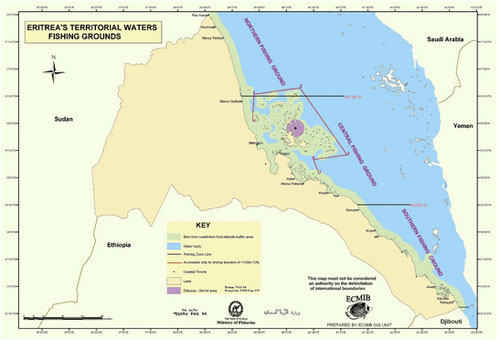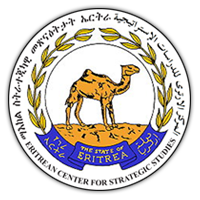January 1, 2012
Fisheries in Eritrea

Map: Fisheries in Eritrea
Brief Background of the Eritrean Fisheries Sector
The Eritrean Fisheries Sector had been active in the 1950¡¯s and 1960¡¯s. The sector was at a relatively developed stage compared to other fisheries in the Sub-Saharan Africa and the Red Sea region as well.
In the then period there were many plants operating in the sector like fishmeal production, ice production, freezing plants, and blank button production and others.
Almost all types of fisheries resources had been exploited and as a result many fishing grounds were discovered. However, the once prosperous sector became obsolete since the end of the 1970¡¯s due to the war of liberation and policy negligence of the colonial regime. Fisheries infrastructures were destroyed and those experienced fishermen were displaced leaving the activity to dormancy.
After liberation, the Government of Eritrea committed its resources to revitalize the sector virtually from zero. In effect the Ministry of Fisheries evolved in 1992 and under which various projects and programs are being run. Fisheries infrastructure is being under development and research is being encouraged for the purpose of proper management and development of resources.
The regulation and coordination of planned investment for the economic and social benefit of the Eritrean people being its mission; the Ministry so far recorded considerable achievements in an attempt to refurbish the sector.
Eritrean coastal areas, Islands
The Eritrean coastline is a low-lying area, very dry and desert like. The temperature lies at about 25-35¡ãC in the cooler season and from 35-45¡ãC in the hot season.
Eritrea¡¯s open sea area offshore is approximately 121,000 sq.km out of which the continental shelf covers about 56,000 sq.km. The main land coastline is approximately 1, 340 Km long. In the Eritrean Red Sea, there are at least 360 off shore islands with greater than 50m wide or long. The total islands¡¯ coastline is approximately 1,980 km long. The islands have a land area of around 1300 sq.km.
About 25% of the continental shelf are occupied by Dahlak archipelago plateau, in depths up 35m. The width of the Eritrean waters varies, being widest (120km) at the latitude of Dahlak and narrowing to the north (15km) and south (30km) of the Archipelago. A much larger area of coral reefs, sea grasses, and Sandy bottoms surround the islands of the Dahlak archipelago.
Sandy deserts and large salt marshes, broken by sand ¡°wadis¡± characterize the Eritrean coastline. Along the shore, there are substantial lengths of sandy beaches. Some Mangrove stands are located in the North around Marsa Ibrahim, in the central region around Massawa and Marsa Fatuma, and to the south around Assab and Barasole, especially in the Islands.
Resources Potential
The waters of the Red Sea are highly productive, supporting substantial populations of diverse marine species, with around 1,000 known species of fish and 220 species of coral. The relative isolation of Red Sea waters and some of its unique water characteristics have produced a high proportion of species not found anywhere else.
The Eritrean part of the Red Sea has not yet been fully utilized due to various reasons. Thus, is very rich in abundance and diversity of resources. There are numerous commercially valuable species, which include:
high value reef fish, especially snappers and groupers concentrated around the coral reefs and on areas of rocky bottom;
a range of other Demersal species, expecially Threadfin bream and lizard fish in the shallower sandy bottom areas;
sharks, currently perhaps the most heavily exploited of Eritrea¡¯s marine resources
crustaceans, including rock lobster, crab and shrimp;
small pelagic fish especially sardine and anchovy, seasonally abundant and close to the shore;
large pelagic fish, including mackerels, tunas and related species;
Other commercial species including aquarium species, sea cucumber, conches (for snail), trochus and perhaps pearl oysters.
Fish species
There are more than 600 fish species found in the Eritrean Red Sea. The commercially important ones can be categorized into five groups. These are Demersal Pelagic, Ornamental, Crustacean, and Cephalopods. Based on this classification, there are 104 Demersal, 79 Ornamental, 26 Pelagic, 2 Crustacean, and 2 Cephalopod species both for local and export market utilization.
Production in 1999
The volume of fish catch has been fluctuating for the last Nine years owing to various reasons. However, the 1999 total catch was the highest volume of Catch ever recorded. It was around 6,870 tons and 18% of which was landed by artisanal fishermen whereas the rest 82% was from Industrial fisheries. The most dominant species, comprised of 97% of the catch in the Artisanal landing were: Spanish Macherel, Snapper, Grouper, Emperor, Job fish, Jacks, Barracuda, Tuna, and Shark in descending order. On the other hand, the top ten species by volume in the Industrial catch in descending order were Lizardfish, Thread fin bream, Grunt, Jack, Emperor, Catfish, Snapper, Barracuda, Grouper, and Shrimp.
Companies involved in Fisheries
Currently there are many companies of local and foreign involved in various fisheries activities. These include: Harena -Boat Yard, Erifish – Fish processing plant, Leda Fish Processing plant, Eripearl -Shell processing plant, Beilul – fishing company, Refco – Refrigeration company, Sea Water Farms Eritrea- Shrimp, Tilapia and Salicornia production co., and many other licensed fishing companies like Saudi Fisheries co., the Egyptians, etc.
Export of Fisheries Products in 1999
With the beginning of trawl operation and renovation of fish processing plants significant amount of fish has been sold to overseas markets in 1999. Soft bottom trawling for small demersal fishes and hard bottom trawling for large demersal fishes have been undertaken by Egyptian and Saudi fisheries companies respectively.
As a result, over 80% of the fish exported were destined to Saudi Arabia and Egypt. In 1999, about 5853 MT of fish were exported and 37% and 34% of which comprises Lizard fish and Thread fin respectively. Large sized fish were also exported to Saudi Arabia by the Saudi fisheries and to European markets such as the Netherlands by the Eritrean Fish Processing Plants.
These fishes with their corresponding proportion of export quantity were as follows: Haemulidae (Grunt) 9%, Carrangidae (Jacks) 4.2%, Ariidae (Cat Fish) 3.4%, Lutjanidae (Snappers) 2%, Scombridae (Mackerels) 1.7%, Serrenidae (Groupers) 1.4%.
Other than the exported finfish, Shellfish comprising of Shrimp – 36.2 MT, Sepia – 2 MT, Sea Cucumber – 7 MT. Shark fin, Dry fish, and Snail nail compose 0.733 MT, 12.816 MT and 0.534 MT respectively were also exported.
Production/Export forecast
Having realized the potential of the resources and the involvement of the local and foreign fishing and processing companies in the fisheries activities, the Ministry has sought the need to boost production of resources at their MSY level for the up coming five years period.
In the year 2000 the Ministry plans to produce 7,000 tons fish and 200 tons of shrimp by the local fishing capacity while allocating a total of 45,000 tons of fish and 300 tons of crustacean to foreign fishing companies.
Beginning with the year 2001 the plan is to increase total landings of the local fishing companies where as reducing the allocation of catches to foreign companies accordingly. With the increase in production and expansion and development of the existing and new processing plants there is an apparent expectation that the volume of export of products will high up correspondingly.
The Egyptian and Saudi markets still remain potential market out lets for exports other the European and North American market which Eritrea is on the verge of penetrating.
Fisheries proclamation and Regulations
Parallel to various development programs, the Ministry of Fisheries has already adopted a Fisheries proclamation and its associated Regulations, proclaimed ¡°GAZETTE OF ERITREAN LAWS¡±, as its obligation to properly manage and develop its fisheries resource for benefit of the country.
For every sub-sector of the fisheries sector, regulations are drafted. The regulations made clear and plain of every procedure ranging from formal request of a license to terminating of an operation. These regulations of the Ministry include:
Proclamation No 104/1998, Legal Notice No 401/1998
The Fisheries Proclamation , The Fishery Product regulations
Proclamation No 105/1998 , Legal Notice No 41/1998
The Fishery Product Proclamation , The Fishery Product Hazard Analysis
Critical Control Points (HACCP) Regulations,Legal Notice No 38/1998 , Legal Notice No 42/1998
The Foreign Fishing Vessel Regulations , The potable Water Regulations
Legal Notice No 39/1998, The National Fishing Vessel Regulations
Investment opportunities
The Eritrean fisheries sector, despite the fact that it is rich in its abundance and diversity of resources, is yet un-exploited. With its 1200kms of coastline and more than 360 islands, the sea offers unlimited opportunities for investment. Past records has it that there were significant number of well – established companies operating in multifarious fisheries activities.
It is, therefore, with this in mind that the Government of Eritrea created a favorable condition of investment in the sector. In the last nine years a number of investors are encouraged to invest on various fisheries sectors either independently or in joint venture with the Ministry of Fisheries.
The main potential sectors for fisheries investment in Eritrea are Aquaculture and wild fisheries on the unitized fish sotck.
The fish condition of Eritrea are unusually favorable for artisanal fishing, especially for high valued food fishes and crustaceans, for which there are strong regional and international markets.
There are also demersal and large pelagic trawl grounds for commercial resources. Small pelagic constitute the largest bulk of the Eritrean fish stock. A number of companies were involved in this business in the past with annual catch of up to 25,000 tons. Besides aquaculture and wild catch. Investment on establishing processing plants to produce and export high value added products has a considerable attraction for investment viewed from the National, Regional and International market contexts.



